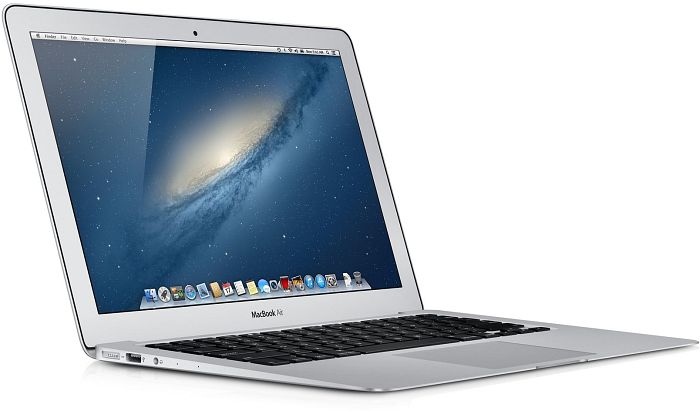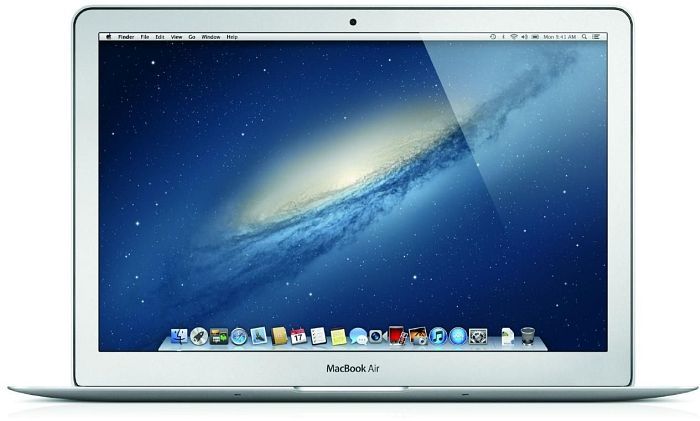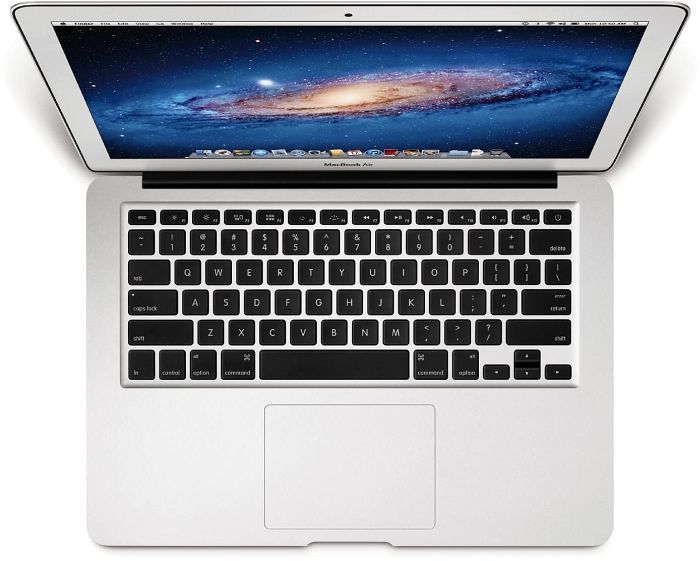Apple MacBook Air 13" Mid 2013
Specifications

Pricecompare
Reviews for the Apple MacBook Air 13" Mid 2013
Source: Techstation.it
 IT→EN Archive.org version
IT→EN Archive.org versionPositive: Aluminum unibody; great portability; excellent colors and good brightness of the display; good autonomy. Negative: Mediocre resolution display; low capacity SSD.
Single Review, online available, Medium, Date: 07/01/2014
Comment
Series: The original MacBook Air, “the world’s thinnest notebook” was introduced at the 2008 keynote by Apple’s former CEO Steve Jobs. Key advantages are thinness, durability, high quality display especially the input device when compare with other netbook at the time. However, it was also heavily criticized for lack of Optical Disc, only one USB port, not user-removable battery among other things. At that time, nobody knows that these disadvantages of the MacBook Air series would be the pinnacle of Intel’s concept for next generation notebooks which will be the newest trend for 2012.
In 2011, Apple has introduced the latest update of the MacBook Air Series, with Intel’s latest Sandy Bridge Series, which doubling the performance. Major advantages of the 2011 MacBook Air in our reviews are the light weight, outstanding, unrivalled design and robust build quality thanks to the aluminum case, very good backlit keyboard plus glass track pad, as well as a very good performance for a subnotebook. The 2011 MacBook Air still shares some of the original’s disadvantages like limited ports, heavily reflective display, non-upgradeable memory and non-user-removable battery. Still, the MacBook Air outclasses almost every other Ultrabook out there with its advantage, save only for Samsung’s newest Series 9 model. On average, the review-ratings are very good, which always assure a place in the top 3 Subnotebook of Notebookcheck.
Rumor has it that Apple will introduce the new MacBook Air within a month during Apple’s usual WWDC with Retina-display, USB 3.0 and Ivy-bridge processor, so stay tune for the newest update of the most popular Ultrabook from the tech giant in Cupertino.
Intel HD Graphics 5000:
ULV integrated GPU (GT3) with 40 EUs (no eDRAM) found on certain Haswell processors.
Non demanding games should be playable with these graphics cards.
» Further information can be found in our Comparison of Mobile Graphics Cards and the corresponding Benchmark List.
Intel Core i7: The Intel Core i7 for laptops is based on the LG1156 Core i5/i7 CPU for desktops. The base clock speed of the CPUs is relatively low, but because of a huge Turbo mode, the cores can dynamically overclock to up to 3.2 GHz (920XM). Therefore, the CPU can be as fast as high clocked dual-core CPUs (using single threaded applications) but still offer the advantage of 4 cores. Because of the large TDP of 45 W / 55 W, the CPU is only intended for large laptops.
4650U:
A Haswell-based ULV dual-core processor clocked at 1.7 GHz with Turbo Boost support up to 3.3 GHz. Offers an integrated HD Graphics 5000 and a dual-channel DDR3 memory controller.
» Further information can be found in our Comparison of Mobile Processsors.13.30":
There are hardly any tablets in this display size range anymore. For subnotebooks, on the other hand, it is the standard format.
The advantage of subnotebooks is that the entire laptop can be small and therefore easily portable. The smaller display also has the advantage of requiring less power, which further improves battery life and thus mobility. The disadvantage is that reading texts is more strenuous on the eyes. High resolutions are more likely to be found in standard laptops.
» To find out how fine a display is, see our DPI List.Apple: Apple is a US company founded in 1976 by Steve Jobs, Steve Wozniak and Ronald Wayne. Headquartered in Cupertino, California, the company is known for its innovative products such as the iPhone, iPad, Mac, and Apple Watch, and manufactures computers and consumer electronics as well as operating systems and application software. Apple is also a leading provider of software and services such as the App Store, iTunes and iCloud.
Apple has earned a reputation as a company that focuses on design and ease of use. As for their notebooks, they are mostly in the high-priced segment, have their own operating system, but also run Windows on the newer Macbooks.
Apple is one of the most valuable companies in the world and has a loyal following of customers and fans. The company also has a strong presence in the entertainment industry, with services like Apple Music and Apple TV+. In 2023, Apple had an approximate 8% market share of global PC sales, ranking it 4th after Lenovo, HP, and Dell.
» Further information can be found in our Notebook Purchase Guide.


 Deutsch
Deutsch English
English Español
Español Français
Français Italiano
Italiano Nederlands
Nederlands Polski
Polski Português
Português Русский
Русский Türkçe
Türkçe Svenska
Svenska Chinese
Chinese Magyar
Magyar


